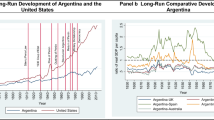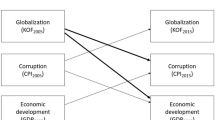Abstract
This research examines the causal impact of institutional quality on economic development from a novel perspective. At the country level, we exploit variation in the natural malaria prevalence in 1900, just before vector-control methods were developed, to instrument for institutional quality using a two-stage least squares instrumental variables framework. Our instrument is a population-weighted average of malaria endemicity estimates for the year 1900 developed by the World Health Organization scientists in the 1960s. We argue that this measure of historical malaria offers more expansive geographic information about the disease environment, and our baseline IV estimates reveal that greater institutional quality causes greater contemporaneous economic growth. Next, we investigate the robustness of these baseline results to alternative explanations, including the role of geography and the role of early colonizers’ experiences, as the causal link between the early disease environmental, institutional quality, and contemporary growth. As an additional test of the explanatory power of malaria endemicity in 1900 as an instrumental variable, we replace our instrument for settler mortality and replicate the core results from the seminal study on colonial origins of comparative development by Acemoglu et al. (2001). In summary, we propose that malaria endemicity estimated for 1900 holistically explains the legacy of early disease on institutional quality development and contemporary economic development, thus significantly contributing to the resolution of the geography versus institutions debate.





Similar content being viewed by others
Notes
Note that for estimation purposes we remove islands and small countries from the analysis because of the likelihood of inaccuracy due to the size of the raster data and spillovers with the ocean.
In the “Replication of Acemoglu, Johnson, and Robinson (2001) Core Results” section, we compare malaria endemicity 1900 and settler’s mortality and argue that malaria endemicity 1900 allows greater variation in terms of variables and sample of colonies.
Regulatory quality is a widely used indicator for institutional quality, along with rule of law, political stability, government effectiveness, among others, as part of WGI developed by Daniel Kaufman and Aart Kraay. The variable “regulatory quality” captures “… perceptions of the ability of the government to formulate and implement sound policies and regulations that permit and promote private-sector development”. Its values vary between − 2.5 and 2.5, with higher values corresponding to higher regulatory quality.
The beta coefficient equivalent was estimated using the standardized variables.
References
Acemoglu, D., S. Johnson, and J. Robinson. 2001. The colonial origins of comparative development: An empirical investigation. The American Economic Review 91 (5): 1369–1401.
Acemoglu, D., S. Johnson, and J. Robinson. 2002. Reversal of fortune: Geography and institutions in the making of the modern world income distribution. Quarterly Journal of Economics 117 (4): 1231–1294.
Albouy, D.Y. 2008. The colonial origins of comparative development: an investigation of the settler mortality data (No. w14130). National Bureau of Economic Research.
Albouy, D. 2012. The colonial origins of comparative development: An empirical investigation: Comment. American Economic Review 102 (6): 3059–3076.
Amoah, B., R.S. McCann, A.N. Kabaghe, M. Mburu, M.G. Chipeta, P. Moraga, ..., and E. Giorgi. 2021. Identifying Plasmodium falciparum transmission patterns through parasite prevalence and entomological inoculation rate. eLife 10: e65682.
Auer, R.A. 2013. Geography, institutions, and the making of comparative development. Journal of Economic Growth 18 (2): 179–215.
Bloom, D.E., D. Canning, and J. Sevilla. 2004. The effect of health on economic growth: A production function approach. World Development 32 (1): 1–13.
Borcan, O., O. Olsson, and L. Putterman. 2018. State history and economic development: Evidence from six millennia. Journal of Economic Growth 23 (1): 1–40.
Carstensen, K., and E. Gundlach. 2005. The primacy of institutions reconsidered: The effects of malaria prevalence in the empirics of development (No. 1210). Kiel Working Paper.
Chanda, A., C.J. Cook, and L. Putterman. 2014. Persistence of fortune: Accounting for population movements, there was no post-Columbian reversal. American Economic Journal: Macroeconomics 6 (3): 1–28.
Clogg, C.C., E. Petkova, and A. Haritou. 1995. Statistical methods for comparing regression coefficients between models. American Journal of Sociology 100 (5): 1261–1293.
Easterly, W., and R. Levine. 2016. The European origins of economic development. Journal of Economic Growth 21 (3): 225–257.
Gallup, J.L., and J.D. Sachs. 2001. The economic burden of malaria. American Journal of Tropical Medicine and Hygiene 64 (1 suppl): 85–96.
Gallup, J.L., J.D. Sachs, and A.D. Mellinger. 1999. Geography and economic development. International Regional Science Review 22 (2): 179–232.
Glaeser, E.L., F. La Porta, R. Lopez-de-Silanes, and A. Schleifer. 2004. Do institutions cause growth? Journal of Economic Growth 9 (3): 271–303.
Gooch, E. 2017. The impact of reduced incidence of malaria and other mosquito-borne diseases on global population. Journal of Development Economics 124: 214–228.
Guo, Z., et al. 2015. Argoecology, demographics, markets, farming systems, agricultural R&D: HarvestChoice 5-Arc minute spatial layers for sub-Saharan Africa release {Version}. HarvestChoice, IFPRI, University of Minnesota. Available online at: http://www.harvestchoice.org/data/. Accessed Sept 2014.
Hay, S.I., C.A. Guerra, A.J. Tatem, A.M. Noor, and R.W. Snow. 2004. The global distribution and population at risk of malaria: Past, present, and future. The Lancet Infectious Diseases 4 (8): 327–338.
Kiszewski, A., A. Mellinger, A. Spielman, P. Malaney, S.E. Sachs, and J. Sachs. 2004. A global index representing the stability of malaria transmission. The American Journal of Tropical Medicine and Hygiene 70 (5): 486–498.
Klein Goldewijk, K. 2001. Estimating global land use change over the past 300 years; the HYDE database. Global Biogeochemical Cycles 15 (2): 417–433.
Klein Goldewijk, K., A. Beusen, and P. Janssen. 2010. Long term dynamic modeling of global population and built-up area in a spatially explicit way, HYDE 3.1. Holocene 20: 565–573.
Kuhn, K.G., D.H. Campbell-Lendrum, B. Armstrong, and C.R. Davies. 2003. Malaria in Britain: Past, present, and future. Proceedings of the National Academy of Sciences 100 (17): 9997–10001.
Lowes, Sara, and Eduardo Montero. 2021. The legacy of colonial medicine in Central Africa. American Economic Review 111(4):1284–1314.
Lysenko, A.J., and I.N. Semashko. 1968. Geography of malaria. A medico-geographic profile of an ancient disease. Medicinskaja Geografija 25–146.
Martens, E.P., W.R. Pestman, A. de Boer, S.V. Belitser, and O.H. Klungel. 2006. Instrumental variables: application and limitations. Epidemiology 260–267.
Packard, R. 2007. The making of a tropical disease. Baltimore: The Johns Hopkins University Press.
Putterman, L., and D.N. Weil. 2010. Post-1500 population flows and the long-run determinants of economic growth and inequality. The Quarterly Journal of Economics 125 (4): 1627–1682.
Rigobon, R., and D. Rodrik. 2005. Rule of law, democracy, openness, and income. Economics of Transition 13 (3): 533–564.
Sachs, J.D. 2003. Institutions don't rule: direct effects of geography on per capita income.
Sachs, J., and P. Malaney. 2002. The economic and social burden of malaria. Nature 415: 680–685.
Sachs, J.D. 2012. Reply to Acemoglu and Robinson’s response to my book review. http://jeffsachs.org/(2012/12/reply-to-acemoglu-and-robinsons-response-to-my-book-review. Accessed 11 Jan 2016.
Smith, D.L., J. Dushoff, R.W. Snow, and S.I. Hay. 2005. The entomological inoculation rate and Plasmodium falciparum infection in African children. Nature 438 (7067): 492–495.
Spolaore, E., and R. Wacziarg. 2009. The diffusion of development. The Quarterly Journal of Economics 124 (2): 469–529.
Author information
Authors and Affiliations
Corresponding author
Additional information
Publisher's Note
Springer Nature remains neutral with regard to jurisdictional claims in published maps and institutional affiliations.
Rights and permissions
Springer Nature or its licensor holds exclusive rights to this article under a publishing agreement with the author(s) or other rightsholder(s); author self-archiving of the accepted manuscript version of this article is solely governed by the terms of such publishing agreement and applicable law.
About this article
Cite this article
Gooch, E., Martinez-Vazquez, J. & Yedgenov, B. The Role of Historical Malaria in Institutions and Contemporary Economic Development. St Comp Int Dev 58, 252–279 (2023). https://doi.org/10.1007/s12116-022-09370-z
Accepted:
Published:
Issue Date:
DOI: https://doi.org/10.1007/s12116-022-09370-z




